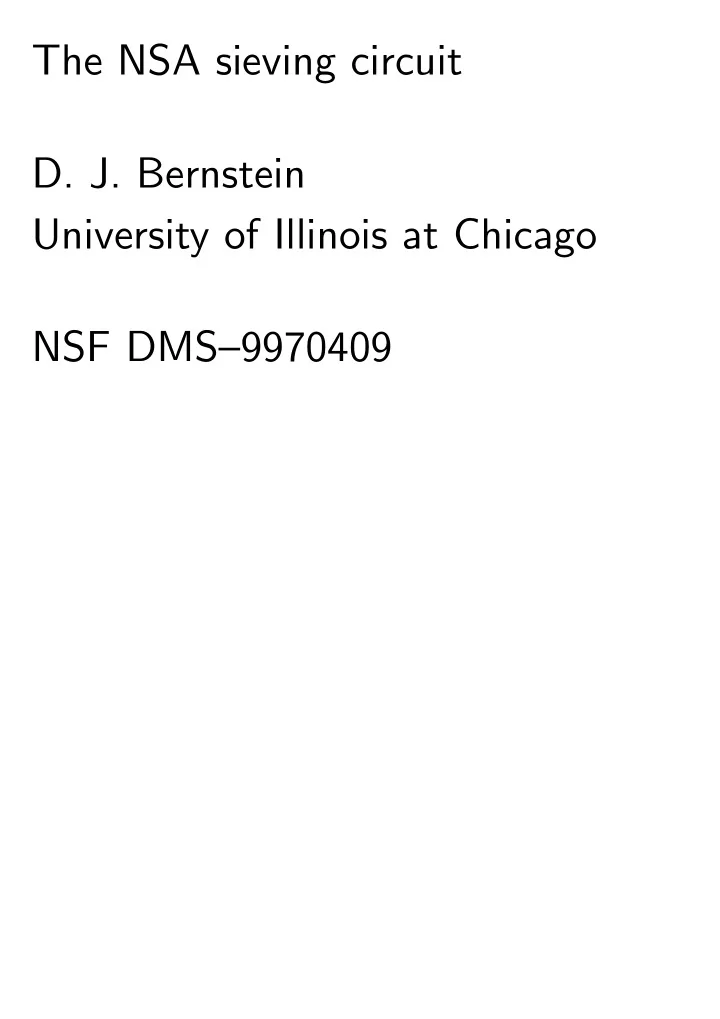

The NSA sieving circuit D. J. Bernstein University of Illinois at Chicago NSF DMS–9970409
Sieving c and 611 + c for small c : 1 612 2 2 3 3 2 2 613 3 3 614 2 4 2 2 615 3 5 5 5 616 2 2 2 7 6 2 3 617 7 7 618 2 3 8 2 2 2 619 9 3 3 620 2 2 5 10 2 5 621 3 3 3 11 622 2 12 2 2 3 623 7 13 624 2 2 2 2 3 14 2 7 625 5 5 5 5 15 3 5 626 2 16 2 2 2 2 627 3 17 628 2 2 18 2 3 3 629 19 630 2 3 3 5 7 20 2 2 5 631 etc.
Have complete factorization of c (611 + c ) for some c ’s. 14 · 625 = 2 1 3 0 5 4 7 1 . 64 · 675 = 2 6 3 3 5 2 7 0 . 75 · 686 = 2 1 3 1 5 2 7 3 . 14 · 64 · 75 · 625 · 675 · 686 = 2 8 3 4 5 8 7 4 = (2 4 3 2 5 4 7 2 ) 2 . 14 · 64 · 75 − 2 4 3 2 5 4 7 2 ; 611 ˘ ¯ gcd = 47. 611 = 47 · 13.
Given n and parameter y : 1. Use powers of primes ≤ y to sieve c and n + c for 1 ≤ c ≤ y 2 . 2. Look for nonempty set of c ’s with c ( n + c ) completely factored and with Q c ( n + c ) square. c 3. Compute gcd { x; n } r Q where x = Q c − c ( n + c ). c c
This is the Q sieve . Same principles: Continued fraction method (Lehmer, Powers, Brillhart, Morrison). Linear sieve (Schroeppel). Quadratic sieve (Pomerance). Number field sieve (Pollard, Buhler, Lenstra, Pomerance, Adleman).
The basic sieve problem Handle sieving in pieces: sieve { n + 1 ; : : : ; n + y } ; sieve { n + y + 1 ; : : : ; n + 2 y } ; sieve { n + 2 y + 1 ; : : : ; n + 3 y } ; etc. The basic sieve problem : Sieve { n + 1 ; n + 2 ; : : : ; n + y } using primes ≤ y . Don’t worry about prime powers.
Trial division For each s ∈ { n + 1 ; : : : ; n + y } : For each prime p ≤ y : Check if p divides s . y 2+ › time, y › hardware. Can handle p ’s in parallel: y 1+ › time, y 1+ › hardware. Georgia Cracker (Pomerance), TWINKLE (Shamir), etc.
Sieving in memory Use array of size y , locations n + 1 ; n + 2 ; : : : ; n + y . For each prime p : For each multiple s of p : Mark p in location s . Total number of marks ≈ P y=p ≈ y log log y . p y 1+ › time, y 1+ › hardware.
In other words: Consider all pairs ( p; s ) where s is a multiple of p . Use a distribution sort to sort these pairs in order of s . Then can see p ’s for each s .
y = 9, n = 611: (2 ; 612) (2 ; 614) (2 ; 616) (2 ; 618) (2 ; 620) (3 ; 612) (3 ; 615) (3 ; 618) (5 ; 615) (5 ; 620) (7 ; 616) Sorted: (2 ; 612) (3 ; 612) (2 ; 614) (3 ; 615) (5 ; 615) (2 ; 616) (7 ; 616) (2 ; 618) (3 ; 618) (2 ; 620) (5 ; 620)
The NSA circuit Build y 1 = 2 × y 1 = 2 mesh of simple processors. Consider all pairs ( p; i ) with 1 ≤ i ≤ ⌈ y=p ⌉ . y 1+ › such pairs. Spread pairs among processors. Build y › pairs ( p; i ) into each processor.
Spread c ’s among processors. Each processor is # c for one c . #1 #2 #3 (2 ; 1)(2 ; 2)(2 ; 3) (5 ; 2)(7 ; 1)(7 ; 2) #4 #5 #6 (2 ; 4)(2 ; 5)(3 ; 1) #7 #8 #9 (3 ; 2)(3 ; 3)(5 ; 1)
Given n : For each ( p; i ), processor generates i th multiple s of p in { n + 1 ; n + 2 ; : : : ; n + y } , if there is one, and sends ( p; s ) to #( s − n ) through the mesh. With random routing: y 1 = 2+ › time, y 1+ › hardware.
Three-dimensional version y 1 = 3+ › time, y 1+ › hardware. Can use Batcher odd-even sort to eliminate randomness and achieve y › circuit depth. But needs long wires. y 1 = 3+ › time, y 1+ › hardware.
Conclusions For sufficiently large y : Don’t trial divide (TWINKLE). Don’t sieve in memory. NSA circuit is much faster.
Recommend
More recommend